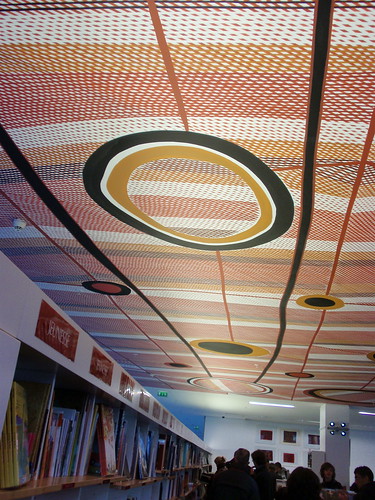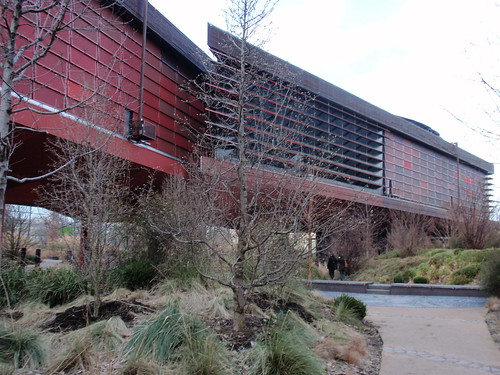The Musee du quai Branly (MQB), whose sub-title is 'where cultures meet in dialogue', was opened in Paris in 2006. It features indigenous art, cultures and civilizations from Africa, Asia, Oceania, and the Americas and brings together collections from the now-closed Musée national des Arts d'Afrique et d'Océanie and the ethnographic department of the Musée de l'Homme. Its opening received quite a lot of publicity in Australia as not only does the museum have collections of bark and modern canvas works by Australian Aboriginal artists, but the ceilings of the administrative building were painted by Ningura Napurrula

[you can't enter the administrative wing, so this photo is taken from outside the building, through the windows]
The bookshop ceiling also features an Indigenous Australian design

It's a very beautiful museum. And very grand. The design is by renowned French architect Jean Nouvel and initially the building featured 'growing walls' - vertically planted gardens that covered sections of the exterior and were meant to symbolise the organic and 'natural' cultures (very controversial notions) that are contained in the museum. Sadly, the growing walls have proved unsustainable, but the surrounding garden of 'wild' grasses survives most atmospherically.

I got into conversation with one of the young people who have been employed most helpfully to explain the exhibits if you wish. In a wonderfully open way she mentioned that the museum had been very controversial and that some people believed it was wrong to display objects that had been...(she searched for an English word, I suggested 'stolen' and she proceeded)...from other cultures. I don't think the Australian exhibits are at all controversial in this way. The bark paintings and the more modern Yuendumu and Papunya canvasses exhibited are all readily available in Australia - if you can afford them. What is most wonderful about the exhibits I saw, and most troubling, is the extensive and very beautiful collection of Melanesian art and artifacts. French colonisation of the Pacific, as well as exploration, study and trading in Papua New Guinea in the late nineteenth and early twentieth century has resulted in an extraordinarily beautiful collection of objects that are no longer available.
The whole concept of the museum has also been challenged. Though the building is modern and the display superb, it is within a dated tradition of museums that sees different cultures, particularly indigenous cultures, as exotic and 'the other'. It's a beautiful display, rather than a 'meeting' of cultures. So, my visit - which I greatly enjoyed - was a rather guilty pleasure.

ps This was the view as we made our way to the metro station in the late afternoon. Paris is like that...you are doing something else and all of a sudden a famous landmark appears.
6 comments:
I have to say how much I am enjoying your descriptions of your time in Paris. My reactions run from - 'oooh I've been there too! to 'Wow! Must go there next time....' But Paris is like that isn't it?
I do hope we have time to catch up with each other when you pass through London.
i felt the same guilt in the british museum. amazing to see bits of the parthenon, but you know, they're bits of the parthenon! what a stunning museum this is tho, and at least people are thinking about what they are doing with this stuff these days. nice view!
Thanks for writing in such detail about your trip and for posting such beautiful pictures. I have really been enjoying seeing Paris through your eyes.
I am really enjoying the travels in and around Paris - very different to my two day tourist-whirlwind visit!
I came here to talk about the British Museum and I see DrK has beat me to it!
One thing I remember from all my world travels is the guide saying 'there used to be an x here, but now it is in the British Museum'. And when you go to the British Museum - man do they have a lot of other people's really good stuff.
I'm loving this travel blog.
I'm a bit ashamed to admit I've not heard of this museum. I think the feelings of guilt, or unease, about the exhibits, are common to many museums (the British in particular, as others have mentioned) - but, to some extent, it is the nature of museums (and things like zoos as well) - they provide perhaps the best (?) method of learning about things outside our immediate experience, but with that comes the history of colonisation/theft etc. I suppose the way the displays are curated should help educate the viewer about those issues, as well as the item/s themselves?
Post a Comment